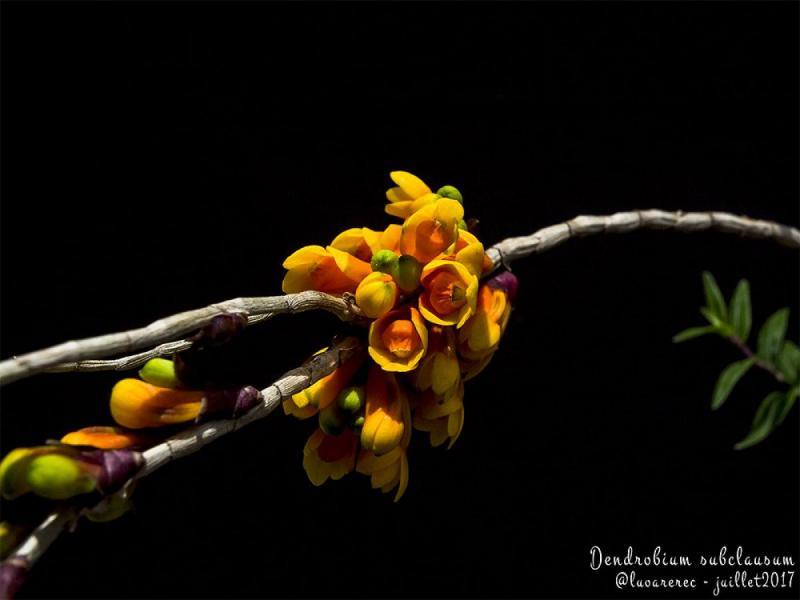Dendrobium subclausum
Also known as: The Almost or Pedilonum mitriferum Pedilonum flammula Dendrobium subclausum var. speciosum Dendrobium subclausum var. pandanicola Dendrobium subclausum var. phlox Dendrobium subclausum h.v. flammula Dendrobium aurantiiflavum Chromatotriccum flammula Chromatotriccum aurantiflavum Chromatotriccum mitriferum Chromatotriccum speciosum Dendrobium aurantiflavum Chromatotriccum phlox Dendrobium lane-poolei Dendrobium strictum Dendrobium mitriferum Chromatotriccum lane-poolei Chromatotriccum pandanicola Dendrobium mitriferum f. alpinum Dendrobium asumburu Chromatotriccum asumburu Chromatotriccum strictum Dendrobium subclausum h.v. pandonicola Dendrobium subclausum var. subclausum Dendrobium phlox Dendrobium flammula Chromatotriccum aurantiiflavum Pedilonum strictum Pedilonum phlox in the subfamily: Epidendroideae
General Information
The Almost is a sympodial cool to warm growing epiphytic orchid belonging to the sub family Epidendroideae.
Plant Description
Sympodial. Grows to 20-183cm. Each new growth has numerous elliptic leaves that grow to 2.5-7.5cm long. Pseudobulbs grow to 20-70cm. The plant forms pendant or arching growths
Substrate(s)
- Coarse
- Spaghnum Moss
Care Notes
This orchid goes into a dormancy phase during winter, during this phase it is best not to provide water unless the plant is starting to look thirsty. The lack of water increases the chance of flowering in spring, and also reduces the likelihood of any rot forming. Do not resume watering until new growth has appeared and is growing strongly.
Often a period of intense growth occurs after dormancy. During this time the amount of light, water and fertiliser the plant receives will directly impact the amount of growth that occurs during this time, and in the case of seedlings, will reduce the time required to reach maturity.
It's recommended to heavily reduce the water amount at the middle to end of autumn to trigger dormancy. Leaves on older bulbs will begin to drop during this time while the newer bulbs continue to mature until terminal leaves appear at the tip of the pseudobulbs.
Repotting can be done any time of the year though it's best to do it in early spring when new growth is appearing as this also means new roots will appear to help the plant anchor into the new media and offset any damage to established roots during the repotting process.
Climate
These orchids thrive in humid, cool, shady conditions with good airflow, they will be found under dense forest canopies where they will receive moderate sun exposure throughout the year.
When cultivated they will thrive in a cool, sheltered environment such as a shaded greenhouse, or if grown in cooler climates they can be grown in the garden in areas where they are protected from frost and receive shade throughout the year, though they may be able to tolerate some morning sun during winter.
Grows at low to high elevations. Rainfall ranges from 51mm to 272mm per day, heaviest in September and lightest in December. Humidity ranges from 67% to 74%, highest in September and lowest in February. Temperature ranges from 11C to 23C, highest in April (13C to 23C) and lowest in January (11C to 22C).Watering
These orchids prefer a constant supply of moisture, with a slight drying out between waterings. Saucers can be placed under pots to retain moisture during hot weather, however the saucers should be removed or let to dry every 1-2 weeks to prevent rot. Keep an eye on the plant especially in hot weather and look for cues of under/overwatering and adjust accordingly.
Fertiliser
These orchids do not need to be regularly fertilised and roots may be sensitive to salt build-up, dying back and therefore impairing the plants growth or even killing it.
If fertilising, use half to quarter of the recommended amount of fertiliser. If they receive fertiliser as part of a collection, be sure to flush out the pots regularly with fresh water and monitor the roots by checking how much resistance is given by the plant when nudged in its pot or mount. If the plant becomes wobbly or loose, repot in fresh mix or rinse the media/mount thoroughly and do not fertilise for at least 3 months.
Use balanced fertiliser year round. Reduce fertiliser when plant is dormant during Spring.Potting
These plants are quite forgiving and will do well repotted ever 2-3 years. The mix should be coarse, well draining, and allow space for air to move and for roots to grow.
Alternatively, these plants will also do well mounted to tree fern or cork slabs, or mounted to trees.
Best time for repotting or mounting the orchids is the end of winter when new growths start to appear. Avoid repotting during hot weather,
This plant does well mounted. Repotting is best done in a pot the same size or only slightly larger than the previous one.





















